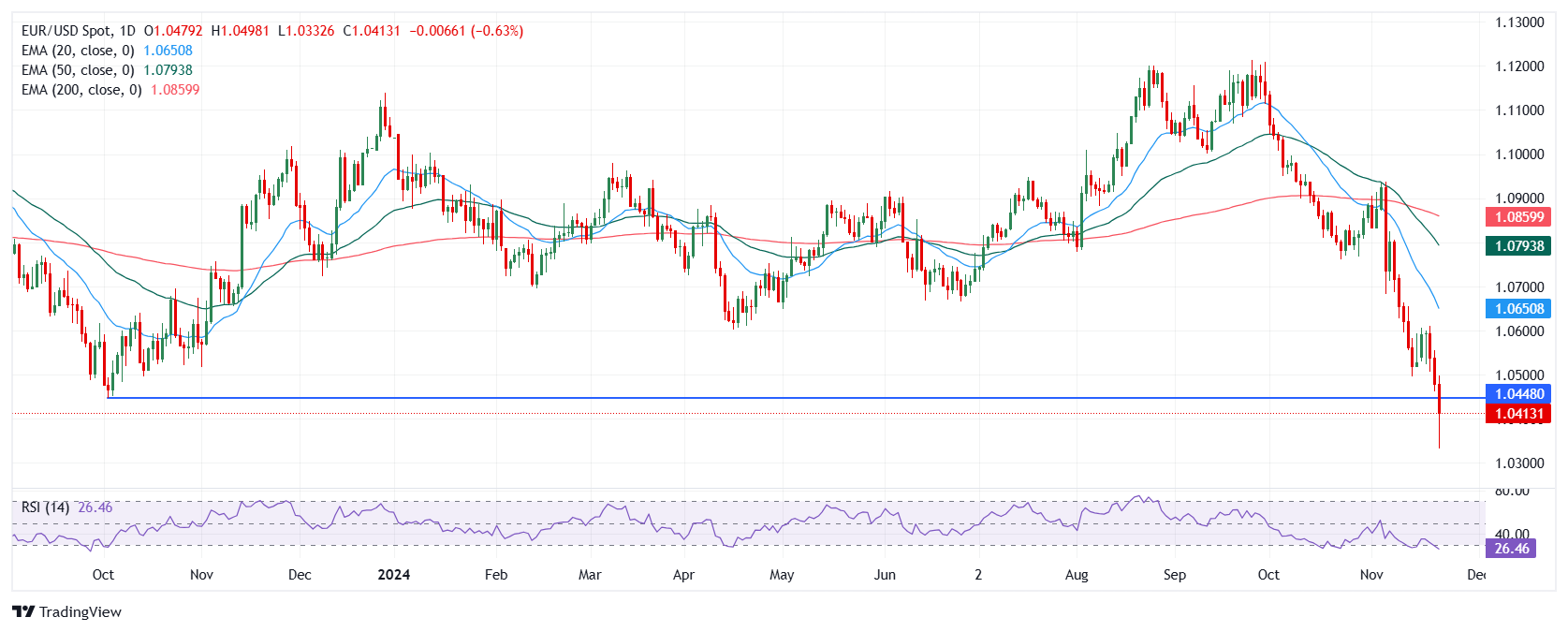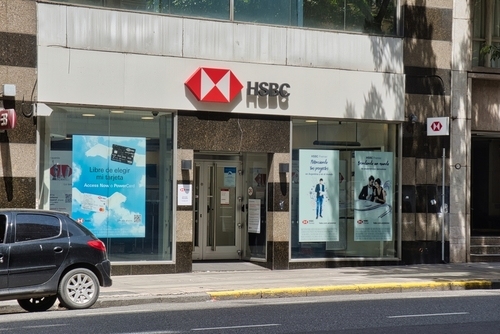EUR/USD sinks to near two-year lows as preliminary Eurozone PMI contracts
Fxstreet
Nov 22, 2024 9:45 AM
- EUR/USD as the US Dollar extends its rally and the Eurozone Composite PMI surprisingly contracts.
- Eurozone Service PMI surprisingly decreased to 49.2, suggesting that business activity contracted in November for the first time since January.
- The US Dollar strengthens as traders doubt over Fed rate cuts in December.
EUR/USD sinks to near two-year lows below 1.0400 in European trading hours on Friday after the release of the preliminary HCOB Eurozone Purchasing Managers Index (PMI) report for November, which showed that the overall business activity surprisingly contracted. The Eurozone Composite PMI declined to 48.1 while economists expected the economic data to manage to remain near the borderline at 50.0. A figure below the 50.0 threshold is considered a contraction in economic activities
A major decline in the overall private business activity came from weakness in the Services PMI, which also contracted unexpectedly. The Services PMI, which gauges activity in the service sector, declined to 49.2 against estimates of 51.8 and the prior release of 51.6. The service sector output contracted for the first time since January.
The Manufacturing PMI continued to contract at a faster-than-expected pace. The index declined sharply to 45.2 against the estimates and the prior release of 46.0
A majority of European Central Bank (ECB) officials are already worried about weak growth and potential economic risks due to expectations of a trade war with the United States (US). On Thursday, ECB chief economist Philip Lane warned that a global trade war due to the likely implementation of President-elect Donald Trump’s higher tariffs would result in a “sizeable” loss in global economic output. "Trade fragmentation entails sizeable output losses,” Lane said.
Meanwhile, Governor of the Central Bank of Cyprus Christodoulos Patsalides said, "If trade restrictions materialize, the outcome may be inflationary, recessionary or worse, stagflationary," Reuters reported.
Daily digest market movers: EUR/USD weakens amid US Dollar’s strength
- EUR/USD faces an intense sell-off as the US Dollar (USD) extends bullish momentum near a two-year high, with the US Dollar Index (DXY) trading above 107.50.
- The outlook of the US Dollar is upbeat on expectations that there will be fewer interest rate cuts from the Federal Reserve (Fed) in its current policy-easing cycle than what market participants had anticipated earlier.
- Market participants expect that United States (US) inflation and economic growth will accelerate when President-elect Donald Trump takes office as his economic agenda includes lower taxes and raising import tariffs by 10% universally, except the Eurozone and China, which are expected to face even higher duties.
- Higher import tariffs and lower taxes will boost business investment, as well as the demand for labor and domestically produced goods and services. A scenario that will be inflationary and force the Fed to remain cautious on interest rate cuts.
- The impact of the hot inflation outlook is visible in market speculation for the Fed interest rate policy for the December meeting. Fed’s probability of reducing interest rates by 25 basis points (bps) to the 4.25%-4.50% range has eased to 56% from 70% a month ago, according to the CME FedWatch tool.
- Going forward, investors will focus on the flash US S&P Global PMI data for November, which will be published at 14:45 GMT. The PMI report is expected to show that the overall business activity expanded at a faster pace due to an improvement in the output of manufacturing as well as the service sector.
Technical Analysis: EUR/USD under pressure below 1.0450

EUR/USD extends downside and reaches a fresh two-year low below 1.0400 on Friday after sliding below the psychological support of 1.0500 the prior day. The pair could witness more downside as all short-to-long-term Exponential Moving Averages (EMAs) are declining.
The 14-day Relative Strength Index (RSI) oscillates in the bearish range of 20.00-40.00, adding to evidence of more weakness in the near term.
Looking down, EUR/USD bottomed at 1.0332 on Friday. Should that level fail to hold, the pair could find a cushion near the round-level support of 1.0300. On the flip side, the psychological level of 1.0500 and the November 20 high round 1.0600 will be the key barriers for the Euro bulls.
Euro FAQs
The Euro is the currency for the 19 European Union countries that belong to the Eurozone. It is the second most heavily traded currency in the world behind the US Dollar. In 2022, it accounted for 31% of all foreign exchange transactions, with an average daily turnover of over $2.2 trillion a day. EUR/USD is the most heavily traded currency pair in the world, accounting for an estimated 30% off all transactions, followed by EUR/JPY (4%), EUR/GBP (3%) and EUR/AUD (2%).
The European Central Bank (ECB) in Frankfurt, Germany, is the reserve bank for the Eurozone. The ECB sets interest rates and manages monetary policy. The ECB’s primary mandate is to maintain price stability, which means either controlling inflation or stimulating growth. Its primary tool is the raising or lowering of interest rates. Relatively high interest rates – or the expectation of higher rates – will usually benefit the Euro and vice versa. The ECB Governing Council makes monetary policy decisions at meetings held eight times a year. Decisions are made by heads of the Eurozone national banks and six permanent members, including the President of the ECB, Christine Lagarde.
Eurozone inflation data, measured by the Harmonized Index of Consumer Prices (HICP), is an important econometric for the Euro. If inflation rises more than expected, especially if above the ECB’s 2% target, it obliges the ECB to raise interest rates to bring it back under control. Relatively high interest rates compared to its counterparts will usually benefit the Euro, as it makes the region more attractive as a place for global investors to park their money.
Data releases gauge the health of the economy and can impact on the Euro. Indicators such as GDP, Manufacturing and Services PMIs, employment, and consumer sentiment surveys can all influence the direction of the single currency. A strong economy is good for the Euro. Not only does it attract more foreign investment but it may encourage the ECB to put up interest rates, which will directly strengthen the Euro. Otherwise, if economic data is weak, the Euro is likely to fall. Economic data for the four largest economies in the euro area (Germany, France, Italy and Spain) are especially significant, as they account for 75% of the Eurozone’s economy.
Another significant data release for the Euro is the Trade Balance. This indicator measures the difference between what a country earns from its exports and what it spends on imports over a given period. If a country produces highly sought after exports then its currency will gain in value purely from the extra demand created from foreign buyers seeking to purchase these goods. Therefore, a positive net Trade Balance strengthens a currency and vice versa for a negative balance.





